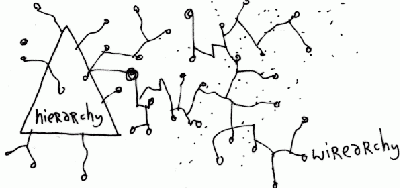 As we’ve been setting up the Agile Elephant, and pulling together our manifesto for social business, we have been having a dialogue about a company’s hierarchy versus the wirearchy – the networked connections that happen inside and outside any company, crossing departmental boundaries, crossing company borders, and completely ignoring the organisation chart on the wall. Wirearchy is a concept coined by our Canadian friend and social business thought leader Jon Husband. It reflects the connected world that we now live in, and it highlights the changes that social technologies are enabling in the way we work. Jon’s working definition of wirearchy is “a dynamic two-way flow of power and authority, based on knowledge, trust, credibility and a focus on results, enabled by interconnected people and technology”. That definition and those key words resonate with us.
As we’ve been setting up the Agile Elephant, and pulling together our manifesto for social business, we have been having a dialogue about a company’s hierarchy versus the wirearchy – the networked connections that happen inside and outside any company, crossing departmental boundaries, crossing company borders, and completely ignoring the organisation chart on the wall. Wirearchy is a concept coined by our Canadian friend and social business thought leader Jon Husband. It reflects the connected world that we now live in, and it highlights the changes that social technologies are enabling in the way we work. Jon’s working definition of wirearchy is “a dynamic two-way flow of power and authority, based on knowledge, trust, credibility and a focus on results, enabled by interconnected people and technology”. That definition and those key words resonate with us.
A few months back Jon introduced me to Brad Palmer, not for any specific reason, but just because he thought we were like minded and should be connected. The wirearchy in action. Brad’s another Canadian, and founder of Jostle. Fast forward to this week and Brad was briefing the Agile Elephant team on what his social intranet platform can do. We’re interested in building up our knowledge of social business tools, and our first look made wirearchy jump in to our minds. Jostle has the most visual approach to showing the structures and networks that evolve in organizations that we’ve seen. Most collaboration products allow employees in the company to build up their profile so that you can understand key information, their skills and expertise and some of their work history. The good products will show you who works for whom. But we haven’t seen a product that shows the company’s org chart AND cross functional team structures as visually as Jostle, but it goes further than that.
The company organization chart always come in for a lot of stick – soon after it’s up on the wall, the noticeboard or a Word document on the Intranet it’s out of date, not completely accurate, and in any case it doesn’t show the real organisation. What would happen if the chart was alive? If the organisation chart was a living social network? That’s what Jostle’s People Engagement® platform gives you. Always up to date and showing the individual’s information with search and functionality to make it easy for others to connect to them based on skills and knowledge. It shows the formal connections of the company hierarchy, but allows people to create ad hoc work groups. They could be project teams, special interest groups, even social groups across and within an organisation. Combined with Jostle’s library functions it offers the possibility for the Intranet to become a repository of learned knowledge, to help connect all that “unstructured” data sitting in Emails and ERP and Excel. People can link easily and quickly across departments, the world and, most importantly, the business silos that grow up in even the smallest company, but are a real challenge to medium sized and larger enterprises. Brad’s explanation showed us how the product would massively reduce the internal time taken in an organisation to find people, find information, and find answers.
A focus on employee engagement, as Jostle has done, has direct business benefits with good outcomes for both employees and customers. Look at this material on the Harvard Business Review blog. Their findings show highly engaged organizations have double the rate of success of lower engaged organizations. John Baldoni reports that:
“high-turnover organizations report 25% lower turnover, and low-turnover organizations report 65% lower turnover. Engagement also improves quality of work and health. For example, higher scoring business units report 48% fewer safety incidents; 41% fewer patient safety incidents; and 41% fewer quality incidents (defects).”
These kinds of social business platforms improve the efficiency of knowledge flow and decision making in any business. In an information business, this would have a major impact on business effectiveness – increasing efficiency as the transaction costs are lowered. We believe there are great opportunities for companies to use Jostle and we’ll be exploring what it can do in the coming weeks and months.

[[ .. and completely ignoring the organisation chart on the wall. ]]
I’m not sure about “completely ignoring”, but certainly viewing and using it differently.
The conditions of being interconnected and using hyperlinks to share pertinent information / knowledge are becoming ubiquitous and won’t go away.
Processes, people and decision-making power will have to adapt. Much more decision-making will also be automated, depending upon the kind of work / organization.
Eventually but certainly.
@Jon – thanks for pulling me up on my extreme language, but more importantly, for amplifying the point so succinctly. Awesome!